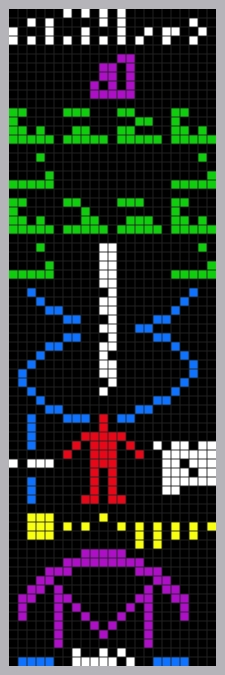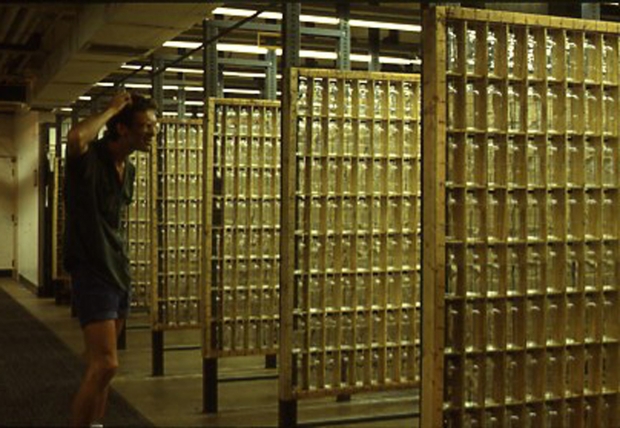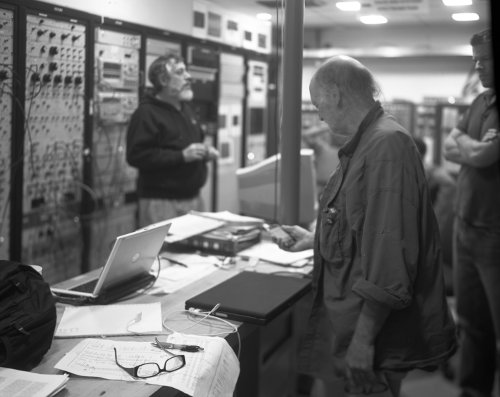
Did Carl Sagan play a role in the famous Arecibo message transmitted toward the Hercules Cluster in 1974? I’ve always assumed so, given Sagan’s connection with Frank Drake, who was then at Cornell University, where Sagan spent most of his career. But opinion seems to vary. Artist/scientist Joe Davis, who now has affiliations with both MIT’s Laboratory of Molecular Structure and Harvard Medical School, noted in an email this morning that Sagan’s widow, Ann Druyan, supports the connection, but according to Davis, Drake himself denied Sagan’s role in the composition or transmission of the message.
I mention all this because of Tuesday’s post on the simulated SETI signal being sent via ESO’s Mars ExoMars Trace Gas Orbiter, as a kind of work of art in its own right as well as a test case in building public involvement in the decoding of an unusual message. The idea of doing that irresistibly recalled Joe Davis because in 1988 Davis performed his own act of scientific art involving SETI, one that involved the Arecibo message and raised the question of whether any recipients would recognize it, much less decode it.
Image: A color-coded version of the Arecibo message highlighting its separate parts. The binary transmission itself carried no color information. Credit: Arne Nordmann / Wikimedia Commons. CC BY-SA 3.0.
The project, called “A Message in Many Bottles,” was set up at MIT’s Hayden Library in 1988. Davis used 1679 ‘Boston round’ 16 ounce glass bottles arrayed in a set of partitioned racks that were displayed in stacks. This is remarkably clever stuff: Each of 18 aisles in the library contained racks of bottles mounted, as Davis told me, 23 across. Empty bottles served as 0s in this digital message, while bottles filled with water represented the 1s. The whole thing reproduced the 1974 Arecibo message.
Now remember, this is MIT. You would think that if there is any place where a population of scientists, academics and students might puzzle out an enigmatic artifact like this, it would be here. Davis puts it this way in his email:
Hayden Library is MIT’s science library and contains all of the information needed to decode the message, all information the message refers to, and supposedly, better-than-average terrestrial intelligence. To the best of my knowledge, nobody decoded it. Instead, there were arguments…about whether or not the racks of bottles constituted works of art.

Image: An evidently baffled student contemplates the “Message in Many Bottles.” Credit: Joe Davis.
In 1997, a year after Sagan’s death, Davis reinstalled the display at MIT’s then new biology facility (Building 68), dedicating the work to the memory of Sagan. A short article on the matter in Nature (27 March 1997) noted the project as an homage to Sagan that accurately reproduced the Arecibo signal, going on to note:
Philip Sharp, chairman of MIT’s biology department, describes the exhibit as a “fitting tribute” to Sagan’s work. “It brings the abstraction of a radar message into an accessible, physical form,” says Sharp. He says he sees “numerous benefits” in having an artist who approaches issues from an unorthodox perspective working alongside more formally trained scientists.
Labeled as a tribute to Sagan and explained so that viewers could decode the message, “A Message in Many Bottles” served as an effective exhibit inhabiting the muzzy borderland where science meets art and creative minds translate research into shapes and forms that interrogate the meaning of our experiments. For that matter, was the Arecibo message itself not a kind of art, given that with a target 25,000 light years away, there was no conceivable way to see it as an actual communication?
Back in 2009 Joe Davis wrote “RuBisCo Stars” and the Riddle of Life for Centauri Dreams, presenting his own work at Arecibo, which wound up, on the 35th anniversary of the Arecibo message, in a new message based on molecular biology that was sent to three nearby stars. How he did this using, remarkably, an analog audio file on his iPhone interfacing with Arecibo’s technology is explained in the second part of his 2009 post, “RuBisCo Stars”: Part II. These two posts are, as everything involving Joe Davis’ work continues to be, invigorating and startlingly thought-provoking.

Image: At Arecibo, Joe Davis ponders transmission options as he holds the possible answer. Credit: Ashley Clark.
In fact, Davis notes in part II, in the midst of explaining to Arecibo’s then interim director Michael Nolan what his project is about, that “projects concerned with the search for extraterrestrial intelligence are really more about a search for ourselves; that they make us look much more intensely at ourselves than we look away into space and that nobody seems to see that part of it.” Nor could the myriad well-trained minds who encountered the Arecibo message in “A Message in Many Bottles” decode its meaning.
Science is so often about asking the right question. What are we staring at right now that we are not seeing? Are we asking the right questions about SETI?



The Arecibo message explained.
It is so human and terrestrial biology centric. Admittedly the message is very compressed in terms of what the data represents, but how in the galaxy is an alien civilization going to be able to correctly interpret the data (especially as human experts could not)?
Indeed, I’d go further and say it presumes a human visual system. i.e the ability to see static images. What if our aliens have a visual system that responds to movement something like insects? Or what if they have an active system like bats or dolphins? Would they send messages in the form of something like a Fast Fourier Transform?
For a concrete example of alternative imaging take a look at neuromorphic sensors or event cameras https://en.m.wikipedia.org/wiki/Event_camera#:~:text=An%20event%20camera%2C%20also%20known,conventional%20(frame)%20cameras%20do.
Bats, dolphins and beings limited to just sonar will never discover stars or planets. They likely couldn’t discover their own planet or sun. When we create the category of “persons and people capable of messaging other star systems” we are selecting for persons and people equipped with the sense organs for experiencing the electromagnetic spectrum. How else will they know about stars systems? As well, we are selecting for persons and people that can expand on their natural senses with technology.
Imho, since exploring the sky makes it obvious that there are many types of star systems, we are also selecting for persons and people who can conceptualize other biologies.
bats and dolphins can see. Their echolocation is more sensitive and appropriate to their environment. Humans are blind to most of the electromagnetic spectrum, and our sense of smell is very poor compared to many mammals.
While we use technology, such as echolocation, radio waves, and gas chromatography to use as sensors, we translate the output to visual media (or sound). Imagine therefore that intelligent echolocation species do the same, translating em sensors to the sonic representations they perceive.
How would they transmit those sonic representations? Conceivably, they may be as difficult to comprehend as our abstract concepts for which we symbolically use word or phrase symbols.
Is the top layer of the above message a number sequence? It looks like it might be a way of representing the number line from 1 to 10 for example. I haven’t look at the Arecibo message explained.
Wait! Wait! If I am reading the Arecibo message correctly it’s saying there are NINE planets in the solar system! Should we issue a correction?
“Empty bottles served as 0s in this digital message, while bottles filled with water represented the 1s.”
Noise can be emulated by evaporation. The longer the message is “transmitted” the noisier it gets, and eventually vanishes entirely.
The bottles were sealed and still hold water decades later. I thought about phase modulation too, where levels of water in those bottles might also be modulated. That said, the message at Hayden Library, unlike Frank Drake’s Arecibo transmission, wasn’t intended to remain intact for 25,000 years. On the other hand, it’s remarkable that 35 years on, this particular message is still communicating with human beings.
Not to side-track the article, but the art forms and just ‘beauty for its own sake’ aspect of these investigations and discoveries (as hinted) almost deserve their own consideration – a ‘take a moment’ to smell the roses. Many of our sensing devices actually create wondrous imagery – Hubble being among the most famous.
Artists have taken note: https://www.thisiscolossal.com/2023/05/chandra-webb-hubble-images/
Excited aliens upon receiving the 1974 message: The earthmen also have Tetris, but they’re not very good at it!
This paper ends with a philisophical question which can be answered with depth psychology. A person’s perception and knowledge does influence or affect their world view. Consequently, one’s view of oneself should be as impersonal and objective as possible, otherwise one’s search options will be limited. It is easy to get trapped in a conservative viewpoint. One has to be patient to catch fish sometimes and that includes ideas.
Imo, the MIT installation is a poor analog for the problem. Any message sender will have to build their message with the symbols provided by nature: electromagnetic waves and frequencies, gravity waves and frequencies, or any yet to be discovered natural symbol. The message sender will be then forced to use syntax, the arrangement of symbols, to stand out from natural syntax. Regardless of the message senders demand for visibility, they must reference the background, natural syntax to stand out as unnatural. The message must offer a problem to be solved.
The MIT installation doesn’t use the natural symbols or reference the natural syntax of its environment. The fact that the installation stands out doesn’t really matter since it references the environment of Art, where it looks natural rather than unnatural. The installation doesn’t present a problem that must be solved or that doesn’t have a natural solution.
Theory of mind is a common, possibly required, trait for social creatures. The ability to conceptualize modes beyond those immediately available to the senses is required to uncover the deeper natural of reality. Imho, space faring ETI who can’t conceptualize other modes of thinking are a logical paradox and a fantasy caricature of our unwillingness to recognize other modes as valuable.
Other space faring people can’t be so unlike us that they break natural laws or lack a combination of symbols and syntax that reference natural objects. The movie Arrival is often used as an example of the “nothing like us” problem, even though the aliens arguably break natural laws and despite being able to draw pictures in the air never bother to do what the humans do with a marker and a whiteboard.
Meanwhile, ant colonies furiously sending out chemical messages are non-plussed at our failure to understand their messages. And who knows what cetaceans are trying to tell us? Orcas have recently resorted to trying to damage boats in Spanish and Portuguese waters. (Maybe it is like the increasing gun violence in the US?)
Photographic images of objects seem like a good way to avoid many of the abstract communication issues exemplified by the Arecibo message. However, even this assumes much about the perceptual abilities of ET. Had we tried to send paintings before perspective was discovered, ET might have been confused by the images. IIRC, it was claimed that people who had only experienced living in round huts were confused by images of our box-like dwellings. Our perception of the flow of time depends on our nervous system. Recently, it has been claimed that plants are far more deliberate in their actions when we speed up their actions, such as finding affordances to anchor themselves. Just how “intelligent” are the chemical transmissions they emit, sometimes mediated through subsurface fungal mats? And again, this is terrestrial life. ET may be very different, even artificial.
The analogy of ant colonies next to a freeway has been used to indicate that we may not even recognize ET artifacts. I would argue that ET, likely much older than our civilization, might be incomprehensible to us, even if “they” visited us today.